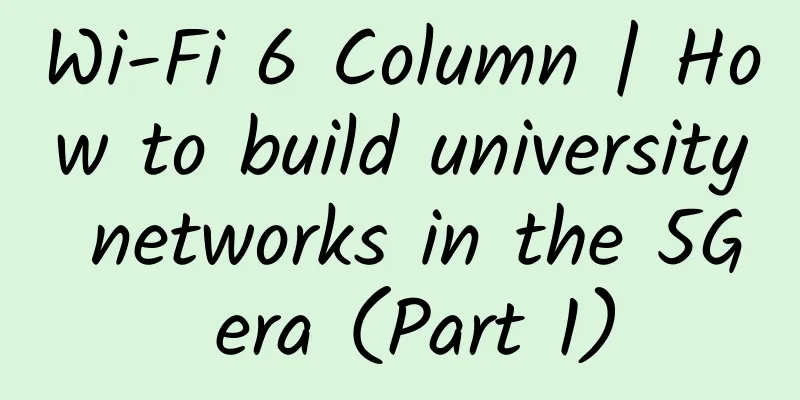Wi-Fi 6 Column | How to build university networks in the 5G era (Part 1)

|
What changes will Wi-Fi 6 and 5G bring to the construction of wireless networks in colleges and universities? In the 5G era, how should wireless networks for higher education be built? This article mainly describes how Ruijie achieves "connectivity convergence and joint deployment" through mobile communication networks and Wi-Fi networks in the era of 3G, 4G and even the upcoming 5G, for university network construction. This article will be divided into two parts. The first part compares Wi-Fi 6 and 5G from a technical perspective and analyzes the demand design behind their technologies; the second part analyzes typical scenario models in universities and provides suggestions for network construction. Today we present to you the first part. 1. The Three Kingdoms of Wireless Protocols Three wireless communication methods It has been more than 120 years since Marconi proposed radio in 1900, and the entire wireless communication has developed a lot of technologies. In this process, there are dozens of wireless communication technologies, and the three most successful ones have formed a three-kingdoms of wireless communication. Mobile communication network (city-level network), wireless local area network (building-level network) and wireless personal area network (room-level network). ▲ The Three Kingdoms of Wireless Protocols Mobile Communications Mobile communications, from CSM in the 1990s to 2G, 3G, 4G and 5G, means that operators have laid out a wireless network in cities that everyone can share. By 2018, the mobile communications network has more than 8 billion users, and more than 1.5 billion new terminals are added each year. This number will be even higher in the 5G era. Wi-Fi Communication The most successful technology for wireless LAN is Wi-Fi. The first generation of Wi-Fi 1 (11b) was born in 1997. To explain, Wi-Fi was previously called 11b, 11a, 11g, 11n and 11ac, all with letter codes. In 2018, the Wi-Fi Alliance unified the codes to use numbers, which is the so-called Wi-Fi 1 to Wi-Fi 6. Wi-Fi 6 officially started commercial products in 2018. As of 2018, there are more than 13 billion Wi-Fi terminals in stock, including every mobile phone, tablet, every PC we use, and many more smart devices. The number of new Wi-Fi terminals added each year exceeds 4 billion, which is 2/3 of the human population on the earth. Bluetooth communication A successful technology for wireless personal area networks is called Bluetooth. The first generation of Bluetooth was launched in the 1990s and has been continuously updated to Bluetooth 5.0. As of 2018, there are more than 15 billion Bluetooth device terminals, mainly used in personal applications such as Bluetooth headsets, Bluetooth speakers, mice and keyboards, and the number of terminals increases by more than 5 billion each year. The Three Kingdoms will also be widely present in the future. The number of terminals based on these three technologies, which are still in existence and newly added, can basically reach one for every person on Earth. This number determines that these three technologies will not disappear. For a long time to come, these terminals will still be widely used in people's lives and production. These technologies have now developed to five or six generations, which also shows that these technologies are very successful and mature. In the future, wireless technology will definitely still be based on these three protocols and technologies on these three paths, and there will be no situation where one replaces the other. 2. Main technologies of 5G 5G Features 5G has many features, and here are a few key features. See the figure above, which are eMBB (network with ultra-large bandwidth), mMTC (Internet of Things with ultra-large connections) and uRLLC (network with high reliability and low latency). 5G has been very popular in the past two years and has now become a national strategy. In fact, 5G is not a technology that suddenly appeared, nor is it a breakthrough technology. In fact, 5G is a continuous update of the 4G technology that everyone is very familiar with. Some of the key technologies it uses are basically the improvement of 4G technology. For example, the bandwidth of 4G is 20 megabits, while the frequency band now opened by 5G is 100 megabits; for example, the antenna of 4G is typically 4 transmit and 4 receive or 8 transmit and 8 receive, and 5G is 64 transmit and 64 receive; in addition, 5G has higher modulation and demodulation technology. Imagination brought by 5G 5G signal processing technology makes its entire bandwidth very high, but the real revolutionary thing about 5G is not that its bandwidth is higher or the Internet is faster. The real revolutionary technology lies in the following two aspects, which bring a lot of imagination to our lives: Mmtc, the Internet of Things with super-large connections, can support the connection of millions of Internet of Things terminals. It can be used for global networks, national networks, and city networks, such as meter reading of water meters, electricity meters, gas meters, etc., as well as shared bicycles, smart manhole covers, smart street lights, etc. uRLCC, a high-reliability, low-latency network, is mainly used for production and autonomous driving applications. For example, driverless car technology will need to be carried on such a network in the future to meet the ever-changing road conditions and emergencies and respond in real time; it also includes real-time control of production workshops and ports that control some automated equipment, such as tower cranes and robots, which all require low-latency wireless networks to carry. 5G is a national strategy Therefore, 5G is a national strategy that needs to be promoted continuously. It is not just about allowing ordinary people to access the Internet faster; rather, the ultra-large connection network and ultra-low latency network will bring great promotion and changes to the automation of the entire society. 3. Current status and forecast of 5G industry chain ▲ Current status and forecast of 5G industry chain From the standard What is the current status and forecast of the 5G industry chain? From the perspective of standards, the standards for large bandwidth access have matured in 2019. In addition, pre-commercial use will be carried out in 2019. Operators have been conducting performance tests in some cities in preparation for formal commercial use. The following two network standards will be completed after 2020. From the terminal It is predicted that by 2020, 5G networks for shared Internet access will be put into commercial use on a small scale, and truly mass-produced 5G mobile phones will be available in 2020. By 2021, Internet access services based on 5G networks will become popular, and 5G mobile phones will be available on a large scale. Of course, by 2021, 5G mobile phones may only account for about 20%, mainly in some high-end mobile phones, and after 2022, 5G mobile phones will become mainstream. Operator's rhythm The three major domestic operators are currently responding to the country's call to build 5G networks. In 2018, the Ministry of Industry and Information Technology allocated 5G frequencies to China Mobile, China Telecom, and China Unicom. In 2019, the three major operators will pre-commercialize, and the Ministry of Industry and Information Technology will issue licenses, thus starting the commercial rhythm of large-scale deployment. In 2020 and 2021, 5G applications will mainly focus on outdoor macro base stations to meet the needs of some cities or entire city-level applications. Operators' deployment will also focus on meeting signal coverage and street blocks, including coverage of some public areas such as airports and railway stations. To truly achieve full indoor coverage, we need to wait until after 2022, when indoor small base stations will be used as 5G indoor coverage solutions. This is the rhythm of the entire 5G industry chain and 5G network deployment. It can be seen that the investment in the construction of 5G networks will be huge. The investment in the entire 4G base station is trillions of dollars, while the frequency of 5G is higher and the coverage is smaller. The investment in deploying base stations may reach 3-5 times that of 4G. Therefore, operators will implement it in stages and steps. 4. Five key new technologies of Wi-Fi 6 ▲ Wi-Fi 6 technical features Wi-Fi 6 is the next generation of Wi-Fi, introducing five key new technologies: 1024QAM (higher rate modulation) brings about an improvement in the ultimate bandwidth. The previous generation of Wi-Fi 4 can theoretically reach a connection rate of 1.7G, which refers to the ultimate bandwidth. After Wi-Fi 6, the ultimate bandwidth can reach 4.8G. OFDMA (Orthogonal Frequency Division Multiple Access) is a technology introduced into Wi-Fi from 4G technology. It solves the problem of balanced transmission of multiple users, making multi-user communication more orderly, thereby improving the experience and efficiency of Wi-Fi. The 8*8 antenna UL/DL MU-MiMO (Multi-User Multiple Input Multiple Output) technology enables the AP to communicate with more end users at the same time, greatly improving concurrent bandwidth and system capacity. BSS-Color (spatial multiplexing technology) solves the problem of how to reduce interference between APs and achieve a better channel spatial multiplexing rate when multiple APs are deployed in high-density scenarios, thereby improving the entire network bandwidth. The smart power saving solution TWT (Target Wake Time) is used in various IoT terminals. Many IoT devices need to rely on batteries and face energy consumption issues. The goal of this technology is to make a battery last for one or two years or even longer. This technology can enable many IoT devices to communicate using Wi-Fi (higher speed). 5. Wi-Fi 6 industry chain status and forecast ▲ Current status and forecast of Wi-Fi 6 industry chain From the standard In 2019, Wi-Fi 6 AP shipments will account for 20%, and it will become the mainstream choice in mid-to-high-end customer scenarios. Higher education is also one of the main industry customers of Wi-Fi 6. By 2020, Wi-Fi 6 will completely replace Wi-Fi 5 and become the mainstream of the entire enterprise network construction. The shipment volume will account for more than 50%, and it will become the standard for basic network construction. Looking back from the birth of Wi-Fi 5 (802.11ac) to its complete replacement of the previous generation Wi-Fi 4 (802.11n), it basically completed the replacement in the education industry within three years. The pace of Wi-Fi 6 is basically similar to that of Wi-Fi 5. From the terminal Generally, mobile phones are the first to be released for the application of new communication standards. In February 2019, Samsung released a Wi-Fi 6 mobile phone worldwide. Xiaomi also released the Xiaomi Mi 9 at the end of February, equipped with a Wi-Fi 6 chip. In September 2019, the new iPhone released by Apple will definitely be equipped with Wi-Fi 6. In 2019, mainstream chip manufacturers will launch Wi-Fi 6 mobile chipsets, and mobile phone manufacturers will also introduce Wi-Fi 6 on their flagship phones. In 2020, Wi-Fi 6 will basically become mainstream. 6. Comparison of 5G and Wi-Fi 6 features ▲ Comprehensive comparison of coverage and performance Applicable scenarios The scenarios of 5G are mainly outdoor, and the considerations are wide coverage, continuity, and mobility; the scenarios of Wi-Fi 6 are mainly indoor, and the considerations are close distance, high-density coverage, and high performance. Comprehensive comparison of coverage and performance 1. Signal and bandwidth From the perspective of signal and bandwidth, 5G uses 256QAM modulation and a single carrier bandwidth of 100 MHz. In comparison, Wi-Fi 6 uses 1024QAM modulation and a single carrier bandwidth of up to 160MHz. It can be seen that the modulation technology and bandwidth used by Wi-Fi 6 are much higher than those of 5G. This is because its distance is short. 5G considers a large range of distances, while Wi-Fi mainly considers a coverage range of 10m-20m. Therefore, the transmission bandwidth at close distances is very high. 2. Scheduling method From the scheduling method, 5G uses base stations to coordinate and use the core network of base stations to command a large number of terminals. Wi-Fi 6 uses a coordination + competition method. Wi-Fi 5 used to be completely competitive, and there was often an imbalance between APs and terminals. Once there were too many terminals, the entire bandwidth was insufficient. This is why you often see strong signals but no communication at conferences with tens of thousands of people, because Wi-Fi 5 is completely competitive, and a large number of competitive conflicts cause the transmission efficiency to drop rapidly. Wi-Fi 6 introduces OFDMA, and APs can coordinate the sending and receiving behaviors of terminals to make the transmission of the entire network more orderly and minimize conflicts as much as possible. 3. Throughput performance Theoretically, 5G can reach 20G, and Wi-Fi 6 can reach 10G. The difference is mainly because 5G can support up to 64 antennas, and a 64-transmit 64-receive antenna would be very, very large, which makes it mainly used outdoors. For a typical single indoor device type, 5G throughput will be between 1.5G and 2G, and it is impossible to use such a large antenna. Most small base stations deployed indoors are generally 4*4, and their bandwidth is 1.5G-2G. Wi-Fi is 4T4R, and the typical performance is also 1.5G-2G. Therefore, the performance of a single device is similar. 4. Coverage Looking at the coverage of a single device, the coverage of a 5G outdoor base station is at the kilometer level, and small base stations or indoor distributed systems are generally used indoors. In order to reduce coverage costs, the coverage of a single 5G capacity cell is between 5,000 and 10,000 square meters, which is about the range of one to two floors. One Wi-Fi AP can cover a large conference room or several rooms in a large office. Each AP provides independent capacity, and its coverage is about 500-1,000 square meters. Indoors, the single-cell coverage of Wi-Fi and 5G is about ten times different. The result of this deployment is that although the performance of a single cell is similar, the average per square meter and per person, the performance of 5G may be only one-fifth to one-tenth of the performance of Wi-Fi. Therefore, 5G first satisfies wide coverage rather than high bandwidth. 5. Personal experience Compared with 4G, 5G will definitely provide a wider coverage and better mobility, and you will no longer feel roaming. However, the disadvantage is just as we have analyzed above. When there are many people, the bandwidth allocated to each person by 5G is not much. There is one base station in 10,000 square meters, and one point has several G. If there are thousands of people, the user experience will be significantly reduced. The advantages and disadvantages of Wi-Fi are just the opposite and complementary to 5G. Its advantage lies in its high bandwidth at high density. Another advantage of Wi-Fi is that it saves power. If you use 4G to access the network for a long time, your phone will get very hot and the battery will run down quickly. Using Wi-Fi will save a lot of power. The disadvantage of Wi-Fi is that it requires authentication, and it is a private network with discontinuous coverage. Just like the school's Wi-Fi, it will disappear as soon as you leave the school, and it will not be as continuous as 5G. Comprehensive comparison from the perspective of construction and management ▲ Comprehensive comparison of construction and management 1. Network control From the perspective of network construction and management rights, the construction and management rights of 5G are the responsibility and leadership of operators, and the owners (universities) only have the right to use. Wi-Fi is a private network, and the owner has full construction rights, management rights and use rights. 2. Network construction standards From the perspective of network construction standards, operators first consider their profit orientation when building networks, and do not guarantee the owner's investment return ratio. However, Wi-Fi networks are business-oriented for owners, and they set the network construction standards based on their business. 3. Deployment method From the deployment point of view, if 5G is used, the school's business must basically be deployed on the public network or cloud. Even if it is deployed on the intranet, there must be a public network address to access it from the outside, and all data must pass through the public network. If Wi-Fi is deployed, the entire business can be deployed in the intranet or LAN. From experience, the owner must have a large number of private network resources that need to be accessed and accessed. 4. Deployment time The deployment time of 5G follows the operator's deployment plan. The operator first considers outdoor deployment. It is actually impossible to know whether the school is within the scope of the entire construction plan. Wi-Fi is completely autonomous and the owner can plan it by himself. 5. Deployment location In terms of deployment location, operators generally deploy Wi-Fi 6 in places with dense traffic from the perspective of revenue. There are also some remote places, such as laboratories and scientific research bases, which are not crowded but very important, so operators may not deploy Wi-Fi 6. There are also such places in schools, where 4G signals cannot reach. Wi-Fi 6 can be deployed according to your needs. 6. Terminal support From the perspective of terminal support, 4G mobile phone applications have been fully popularized. 5G is expected to be gradually popularized between 2020 and 2024. PC and Pad support for operators is much slower. For example, the number of laptops with built-in 4G functions is still less than 20%; and smart office, such as large screens with smart projection and some voice smart office equipment, currently does not support 4G or 5G. Wi-Fi is standard on these products. In the next two to three years, Wi-Fi 6 will definitely become the mainstream of such devices. The above is a comparison of the needs and applications of Wi-Fi 6 and 5G from a technical perspective. As for how to build a network in a campus scenario based on 5G and Wi-Fi 6 technologies, we will discuss it in the next article. |
Recommend
Unleashing the power of 5G: Innovative devices will revolutionize connectivity
There’s no denying that the advent of 5G technolo...
IT Viewpoint: Five major network challenges for 2019
Frank Scalzo, network director at data center ope...
How many base stations are there in the world? How many 5G base stations are there?
According to the latest statistics from Omdia, th...
2022 Gartner Online Fraud Market Guide Report is officially released, Ruishu Information is once again selected as a representative manufacturer
In December 2022, Gartner®, a global authoritativ...
What the hell are the three-way handshake and the four-way wave?
[[382042]] This article is reprinted from the WeC...
Five Factors Contributing to Decibel Loss in Fiber Optic Cables
High decibel losses in fiber optic cable infrastr...
CloudCone: $69/month-E3-1270v2, 32G memory, 512G SSD, 100M/1Gbps bandwidth, Los Angeles MC data center
We often share information about VPS hosts provid...
Why 5G Private Networks Are Critical to Enterprise Digital Transformation
Today’s enterprise manufacturing facilities are u...
5G is still a long way off, but some people are already discussing 6G
It often takes many years for network technology ...
100G network service acceleration platform T1 GateWare is newly launched
[51CTO.com article] On October 17, 2017, Beijing ...
Adding more content rights makes 5G packages more popular
China Telecom's 5G package users have accumul...
How did the No. 1 brand of domestic load balancing products become successful? Here’s the answer from Deepin Technology!
According to IDC data in the first quarter of 201...
Riverbed Helps Maersk, the World's Largest Container Shipping Company, Achieve Digital Transformation
Riverbed Technology, the application performance ...
CloudCone Easter Sale: $14.28/year - 1GB/45GB/4TB/Los Angeles Data Center
CloudCone's Easter sale started today, offeri...
5G is here! Technology trends and standards you must know
In 2017, the application of 5G technology has bec...









